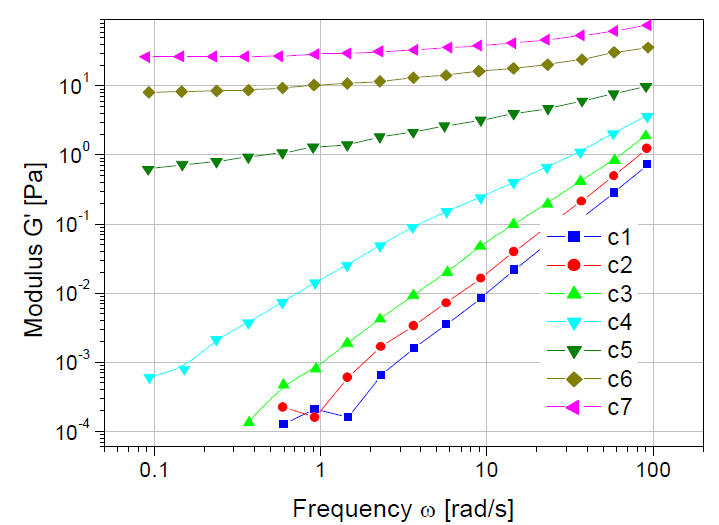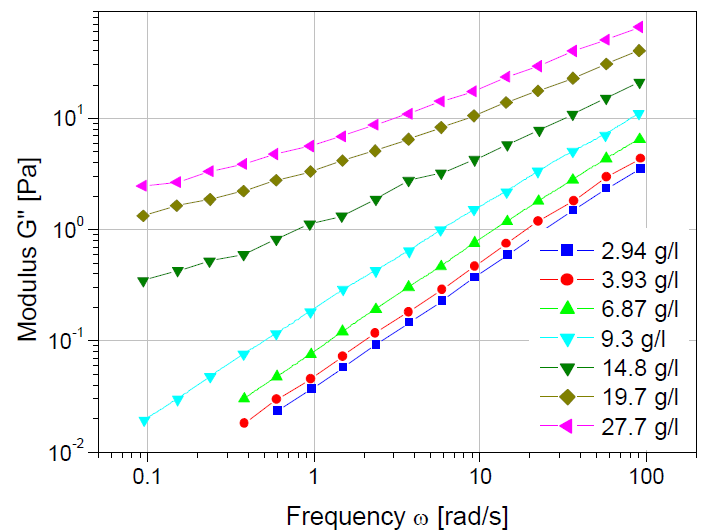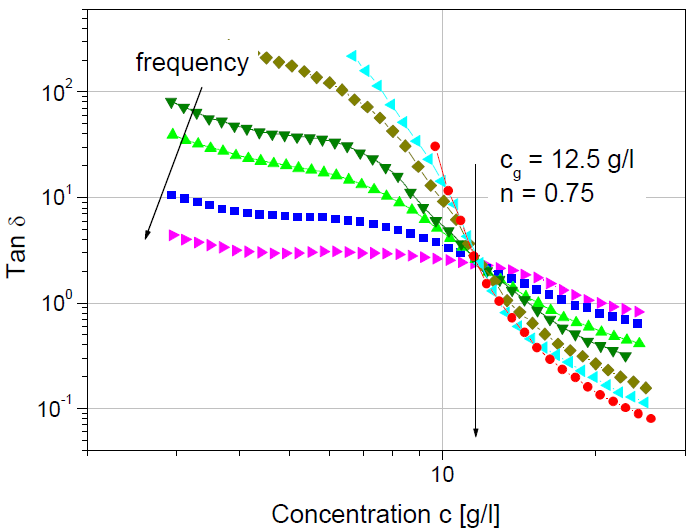Sol Gel transition of PVC plastisols
by Yao Ming Long, TA Instruments
Keywords: PVC plastisols, gel point, DOP, viscoelastic spectrum, sol-gel transition
DETERMINING THE SOL-GEI TRANSITION OF PVC GELS
A polymeric gel is a three dimensional network forming from flexible chains through chemical crosslinking or physical interaction. The transition from the liquid state (sol) to the solid state (gel) is called the sol-gel transition and the critical point for the transition is defined as the gel point. To study a gelling material, it is important to have a method to determine the gel point in an accurate and reproducible manner. Rheologically, the independence of the loss tangent of frequency at the gel point has been widely used to measure the gel point for chemical and physical gels.


Figure 1: Storage Modulus of PVC in DOP as a function of concentration

Figure 2: Loss Modulus of PVC in DOP as a function of concentration
n is the critical exponent characterizing the viscoelastic nature of a gelling material at the gel point. If the gel strength (elastic modulus) at the gel point is weak, an accurate measurement of the gel point requires high torque sensitivity of the rheometer.
Poly vinyl chloride (PVC) is known to form physical gels in numerous solvents (plasticizers). Bi(2-ethyhexyl) phthalate (DOP) is one of most used plasticizers for PVC. A PVC/DOP system was prepared at room temperature as a function of polymer concentration. PVC has a weight-average molecular weight Mw of 250,000 and a polydispersity Mw/Mn of 2.2.
The dynamic measurements were carried out at 400C on an ARES rheometer equipped with a force transducer using cone/plate test fixtures. The elastic modulus G’, loss modulus G”, and loss tangent tan d were measured on each sample in a frequency run from 0.1 to 100rad/s. The linear response of dynamic viscoelaticity was ensured by applying the suitable amplitude of shear.
The shear storage modulus G’ and the loss modulus G"are shown in Figures 1 and 2 as a function of the angular frequency for the PVC/DOP samples. The polymer concentration ranges from 2.94 to 24.7 g/l. The PVC/DOP samples follow a liquid-like terminal behavior at very low concentrations while the deviation from the above relations becomes more pronounced for the higher concentrations of PVC.

The behavior, G’ (w) = constant at w®0 indicates the formation of a rubbery plateau. The slope of the G’(w) versus w (at w®0) in a log-log plot undergoes a change from 2 to 0, while that of the G”(w) versus w (at w®0) varies from 1 to 0. Therefore, it is reasonable to consider that the liquid-solid transition should take place at some value of the slope between 0 and 2 for the G’(w) curves or at a slope between 0 and 1 for the G”(w) curves. Furthermore, it is obvious that at the gel point both slopes are the same. This consideration is an approach to the onset of the rheological definitionof the gel point.
Based on equation (1) the gel point can be easily determined. The method is known as frequency independence of tan d. It is convenient to create a multifrequency plot of tan d versus gelation time, temperature, or concentration, depending on which parameter governs the gelation process. In the present case, tan d versus polymer concentration at different frequencies provides the desired information on the gel point, as shown in Figure 3. All curves in the figure cross at one common point on the polymer concentration axis (12.5 g/l). This point is defined as the gel point cgel. The critical exponent n, directly calculated from the gel point using (1), was found to be 0.75. With a high sensitivity transducer, accurate and easy measurement of the gel point for PVC plastisols using the method based on the frequency independence of tan d could be performed.

Figure 3: The cross over point of tan d as a function of concentration defines the gel point

